World War II

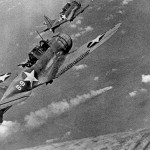 The Japanese navy in 1942 was a power that seemed impossible to beat. They had not lost a battle since their defeat the Battle of Shimonoseki Straits in 1863. It was the goal of the Japanese operation to eliminate the United States as a strategic power in the Pacific…the same reason the attack on Pearl Harbor was important to them. On June 4, 1942, Japanese Admiral Chuichi Nagumo, commander of the fleet that attacked Pearl Harbor, launched a raid on Midway Island with almost the entire Japanese navy. It was to be a decisive battle. Their plan was to make another power grab that that would widen their sphere of influence and conquest. They set their sights on Midway, an island group in the central Pacific, as well as on the Aleutians, off the coast of Alaska. The United States Navy was badly wounded, and the Japanese were determined to finish it off.
The Japanese navy in 1942 was a power that seemed impossible to beat. They had not lost a battle since their defeat the Battle of Shimonoseki Straits in 1863. It was the goal of the Japanese operation to eliminate the United States as a strategic power in the Pacific…the same reason the attack on Pearl Harbor was important to them. On June 4, 1942, Japanese Admiral Chuichi Nagumo, commander of the fleet that attacked Pearl Harbor, launched a raid on Midway Island with almost the entire Japanese navy. It was to be a decisive battle. Their plan was to make another power grab that that would widen their sphere of influence and conquest. They set their sights on Midway, an island group in the central Pacific, as well as on the Aleutians, off the coast of Alaska. The United States Navy was badly wounded, and the Japanese were determined to finish it off.
The Americans were weakened, that was true, but the Japanese sorely misjudged the determination of the American warrior. The Yorktown had been damaged, and there would only be three days to get her repaired and ready for battle. She would be used, along with the Enterprise and the Hornet for this battle. They were all that was left of the aircraft carriers after the attack on Pearl Harbor. The question on the minds of everyone…would it be enough? Only time would tell. And there was no more time. The battle had begun.
The attack came in the morning, on June 4th. Admiral Nagumo wanted to lure the United States aircraft carriers into a trap. He launched his first strike with 108 aircraft…bringing significant damage to the US installations at Midway. The Americans struck back over and over, but accomplished little, losing 65 of their aircraft in those first attempts. The Japanese admiral was sure that his plan had worked. He could almost taste victory, but he had underestimated the tenacity and determination of Admiral Chester Nimitz and Admiral Raymond Spruance, the commanders of the American forces. Admiral Nagumo ordered a second wave of bombers to finish off what he thought was only a remnant of American resistance. This was when he found out just how wrong he had been, and how badly he had misjudged the Americans. The American Admirals had anticipated the attack on Midway, and they managed to conceal their position because of good reconnaissance, which gave them sufficient opportunity to rearm.
The Americans sent in 55 US dive-bombers to take full advantage of Admiral Nagumo’s confusion. He honestly thought this battle would be a simple, but decisive win for the Japanese, but his world came crashing down when the Americans sunk three of the four Japanese carriers, all of them cluttered with aircraft and fuel, ready to launch another attack. The realization came to Admiral Nagumo after it was too late. The Americans had a much larger naval force that he had expected. The Japanese carrier, the Hiryu was crippled, but not before it finished off the American carrier Yorktown.
The attack on Midway was a complete disaster for the Japanese. In all, they lost 322 aircraft and 3,500 men. 
 They were forced to withdraw from the area before even attempting a landing on the island that had been their goal for the attack. Midway was safe, and the Japanese went away with a major lesson learned. The Battle of Midway took place roughly at the middle of World War II, and things went downhill from that point on for the Japanese. They would not win this war, but rather would surrender on September 2, 1945. They took away a new understanding of the American war machine after World War II. The United States was a formidable foe, and one that refused to give up to evil nations.
They were forced to withdraw from the area before even attempting a landing on the island that had been their goal for the attack. Midway was safe, and the Japanese went away with a major lesson learned. The Battle of Midway took place roughly at the middle of World War II, and things went downhill from that point on for the Japanese. They would not win this war, but rather would surrender on September 2, 1945. They took away a new understanding of the American war machine after World War II. The United States was a formidable foe, and one that refused to give up to evil nations.
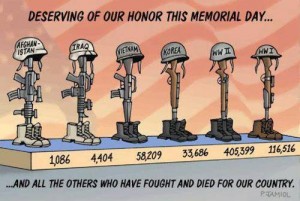 Our country has been involved in so many wars in its relatively short history, protecting both our freedom and many other countries from the oppression imposed by so many evil dictators and nations. Some people don’t think the United States should be the guardian of the nations, but when push comes to shove, the United States is always the one they call to come in and save them. In all reality, the only countries who wish we would just stay out of things, are the ones who have overstepped their boundaries, and are trying to do evil in the helpless nations they have occupied.
Our country has been involved in so many wars in its relatively short history, protecting both our freedom and many other countries from the oppression imposed by so many evil dictators and nations. Some people don’t think the United States should be the guardian of the nations, but when push comes to shove, the United States is always the one they call to come in and save them. In all reality, the only countries who wish we would just stay out of things, are the ones who have overstepped their boundaries, and are trying to do evil in the helpless nations they have occupied.
Of course, no military machine can function without the sacrifice in time and lives of people. Military men and women who are willing to make that sacrifice are a rare breed indeed. True, in years past there was a draft, but even then, there were those who volunteered, like my dad and many others. They saw a need, and knew that they had to answer the call to duty.
Over the course of the major wars the United States has been involved in beginning at World War I, we have lost a total of 619,300 men and women. That is an astounding number of people. Fighting evil is a costly business, both in money, and more importantly in the lives we have lost. Nevertheless, if we allow evil to prevail, we are in a far worse position. That is something every soldier knows all too well. It is what brings them to the point of making the decision to serve…to fight, and give their lives if necessary. It isn’t that they don’t know what they are getting into, because they do. They know that as a soldier, they will be taking the 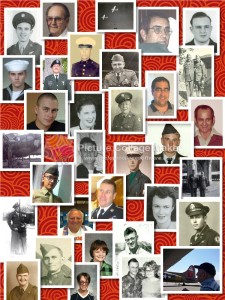 ultimate chance with their life, and they know that they may lose their life. And yet they serve. That is the picture of a true hero.
ultimate chance with their life, and they know that they may lose their life. And yet they serve. That is the picture of a true hero.
There are those who condemn our soldiers for their sacrifice, those who protest, and scream hate at them, but what they don’t really understand is that their very right to protest, scream, and even hate, comes from the fight our soldiers have waged to protect that very freedom. It is a tough job, and often thankless, but they fight because they can see what is right and what is wrong. It is wrong for anyone to steal the freedoms of another human being, and it is wrong for them to try to force their will on others. Soldiers have the vision to see this, and even when hate is aimed at them, they will fight for the rights of those who hate. Yes, soldiers are a rare breed, and they are heroes. They deserve our respect, and they deserve the honor and respect that this day is all about. Happy Memorial Day!! Be sure to thank a Veteran today.
 Going through your parents things after they have passed away, is one of the hardest and most time consuming things you will ever do. It is also one of the most rewarding. With the passing of our mother last month, my sisters and I now beginning the task of going through the treasures of their lifetime. Their house has been in our family for about 56 years, and in that time they gathered many things. Of course, like every long term household, there were things to be thrown away, but I think what really surprised us was that there were many things that we didn’t want to throw away. In reality, they really kept only the really good things…the treasures of a lifetime filled with love, laughter, and happiness.
Going through your parents things after they have passed away, is one of the hardest and most time consuming things you will ever do. It is also one of the most rewarding. With the passing of our mother last month, my sisters and I now beginning the task of going through the treasures of their lifetime. Their house has been in our family for about 56 years, and in that time they gathered many things. Of course, like every long term household, there were things to be thrown away, but I think what really surprised us was that there were many things that we didn’t want to throw away. In reality, they really kept only the really good things…the treasures of a lifetime filled with love, laughter, and happiness.
There were treasures of our dad’s military days, including old newspapers from World War II, Dad’s soldier’s handbook, pilots manuals, and a training manual from his flight engineer training. There were baby clothes he had worn, as well as his Christian books. Treasures from their Silver and Gold Wedding Anniversaries, and souvenirs they had collected over the years. And there were pictures…lots and lots of pictures There were pictures from our childhood, pictures from his war years, pictures from Mom’s younger years, and Dad’s younger years…so many pictures. Of course, those will be scanned so that we can all have copies of them, and then we will divide them up. We didn’t even have much time to really look at them, but we could tell that they are treasures, because they are the stories of many lifetimes.
I don’t think that any of us could really fully comprehend all of what we had in front of us, but as time goes on, we will really realize what gifts we have been given. These were the things that our parents loved. They were the things that they searched for. Especially the souvenirs, because Mom and Dad loved to travel, and they loved to have mementos of those trips. They traveled to so many places. They truly, really lived, and the things 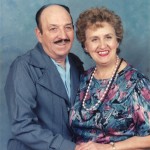 they kept were the things that reminded them of all the wonderful times they had on those trips…their treasured memories.
they kept were the things that reminded them of all the wonderful times they had on those trips…their treasured memories.
I’m sure that as time goes on, there will be many stories to tell about all they things they have done in their amazing lives, but that will be a story for another day. For now, the biggest story of the day is the discovery of these, the many treasures of two lives so very well lived. Nothing held them back. They did the things they wanted to do. In fact, it never occurred to them to think they could do anything they wanted to do. They just went out and did the things they wanted to do. They built a beautiful lifetime, and then left us the treasures of that lifetime.
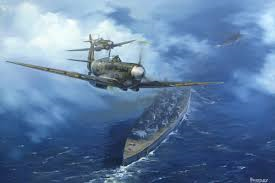 In any war, each side has just one goal in mind…winning. Of course, this is not just a video game or war games, but it is really a life and death challenge. In retrospect, I find it interesting to see some of the strategies the different sides use. While I cannot agree with anything the Germans did under Hitler’s rule, because Hitler was unbelievably ruthless, hateful, and cruel, there were some strategies that either he, his admirals, or his soldiers executed that were quite spectacular, though surprising in nature, because the Germans didn’t usually coordinate their efforts this well. I would never have wanted the Germans to win in World War II, because of their horrible treatment and murders of the Jewish people, but they did have a way of fighting that has captured my interest…at least on this day.
In any war, each side has just one goal in mind…winning. Of course, this is not just a video game or war games, but it is really a life and death challenge. In retrospect, I find it interesting to see some of the strategies the different sides use. While I cannot agree with anything the Germans did under Hitler’s rule, because Hitler was unbelievably ruthless, hateful, and cruel, there were some strategies that either he, his admirals, or his soldiers executed that were quite spectacular, though surprising in nature, because the Germans didn’t usually coordinate their efforts this well. I would never have wanted the Germans to win in World War II, because of their horrible treatment and murders of the Jewish people, but they did have a way of fighting that has captured my interest…at least on this day.
The Germans had controlled and occupied France since June of 1940. Their ships docked in French ports were drawing fire from the British. It became clear that the ships needed to escape. The German battleships Gneisenau and Scharnhorst had been anchored at the port of Brest since March of 1941, and the heavy cruiser, Prinz Eugen had been there since May of 1941. They were periodically subjected to bombing raids and damage at the hands of the British. Now it was time to turn a bad situation into a successful failure, as it were. The Germans knew they were not going to hold onto France here, so now they needed to steal away in the night without getting caught.
It was decided that they would make a mad dash up the English Channel to the safety of German waters. The 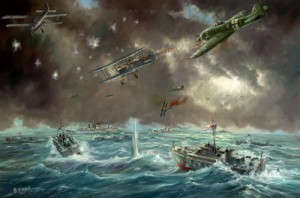 key here was to make the Channel Dash right under the watchful eye of the British Royal Navy without their notice. It was quite risky. Despite the watchfulness of the British submarines and aircraft, the German Vice Admiral, Otto Ciliax launched Operation Cerberus to lead the ships out of the French port, and to the safety of the German ports.
key here was to make the Channel Dash right under the watchful eye of the British Royal Navy without their notice. It was quite risky. Despite the watchfulness of the British submarines and aircraft, the German Vice Admiral, Otto Ciliax launched Operation Cerberus to lead the ships out of the French port, and to the safety of the German ports.
On the evening of February 11, 1942, they set their plan in motion. Accompanied by six German destroyers and twenty one torpedo boats for protection, they moved north late that evening. When daylight hit, they were joined by German planes to provide air cover as well. The air cover was led by ace pilot, Adolf Galland. He was joined by 250 other fighters in a coordinated joint effort of the German Navy and the Luftwaffe…an unusually well coordinated joint effort. The British Royal Navy scrambled to coordinate its own attack, but the late start would prove to be the undoing of the attack, because they did not realize that the escape was in progress until the afternoon of February 12th. All three of the German warships made it to a German port on February 13th, although the Gneisenau and had incurred damaged by British mines along the route. In addition to the embarrassment of the well planned escape that was carried out by the Germans, the British lost 40 aircraft and six Navy Swordfish during their confrontation. The Germans, on the other had, only lost one torpedo boat and 17 aircraft.
Nevertheless, the British would exact a revenge of sorts, when British warships sunk the Scharnhorst in December of 1944, as it attempted to attack a Russian convoy. The Gneisenau was destroyed during a bombing raid, while it was still being repaired from the prior damage, and the Prinz Eugen survived the war, but 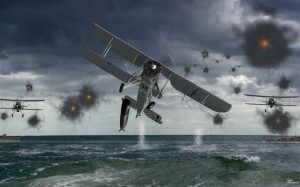 was taken over by the US Navy at the end of the war. It isn’t that I want to commend the Germans for their sneaky escape, because I don’t. They simply lived to fight…and ultimately lose, another day. It was, however, a good strategy, and I guess that even crazy dictators like Hitler, and the men he trained, could come up with an occasional good escape plan. Nevertheless, evil must not be allowed to continue, and the Germans had to be shut down, so the British, and all the other nations who stand for what is good, had to continue to fight, until Germany and its allies had no choice but to surrender. Still, February 11, 1942, the day of The Channel Dash would stand out as one of the best fights put up by the Germans, or at least, the best escape plan.
was taken over by the US Navy at the end of the war. It isn’t that I want to commend the Germans for their sneaky escape, because I don’t. They simply lived to fight…and ultimately lose, another day. It was, however, a good strategy, and I guess that even crazy dictators like Hitler, and the men he trained, could come up with an occasional good escape plan. Nevertheless, evil must not be allowed to continue, and the Germans had to be shut down, so the British, and all the other nations who stand for what is good, had to continue to fight, until Germany and its allies had no choice but to surrender. Still, February 11, 1942, the day of The Channel Dash would stand out as one of the best fights put up by the Germans, or at least, the best escape plan.
 Living to be 95 years old is an amazing accomplishment, and one that few people are blessed enough to achieve. Today, that is the place where my husband, Bob’s great uncle, Frank Knox is. I think Frank was always my mother-in-law, Joann Schulenberg’s favorite uncle…doesn’t every girl have one or even two. When I found my mother-in-law’s childhood scrapbook among the photo albums and old pictures she had in a box in her closet, as we were preparing to sell their home to help pay for her care, after my father-in-law passed away, I noticed several pictures with her and her Uncle Frank, as well as pictures of him alone.
Living to be 95 years old is an amazing accomplishment, and one that few people are blessed enough to achieve. Today, that is the place where my husband, Bob’s great uncle, Frank Knox is. I think Frank was always my mother-in-law, Joann Schulenberg’s favorite uncle…doesn’t every girl have one or even two. When I found my mother-in-law’s childhood scrapbook among the photo albums and old pictures she had in a box in her closet, as we were preparing to sell their home to help pay for her care, after my father-in-law passed away, I noticed several pictures with her and her Uncle Frank, as well as pictures of him alone.
Frank was stationed in England during World War II, as was my dad. I’m not sure where in England, but it would have been interesting to see if they ever crossed paths. It’s possible that worry and the unknown were things that made my mother-in-law love 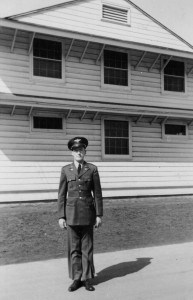 seeing her uncle, because even when kids are young, they are well able to understand the dangers that their loved ones are being placed in, and they worry that they will not make it home. There really is no definite skill that keeps a soldier alive in a war. Some just come home, and others don’t. That is probably the thing that makes the homecoming so very sweet.
seeing her uncle, because even when kids are young, they are well able to understand the dangers that their loved ones are being placed in, and they worry that they will not make it home. There really is no definite skill that keeps a soldier alive in a war. Some just come home, and others don’t. That is probably the thing that makes the homecoming so very sweet.
The first time I met Frank was the end of June, 1976, when they brought Frank’s parents, my mother-in-law’s grandparents for a visit. It was partly, I’m sure so that they could meet their two great great granddaughters, my girls, Corrie and Amy, but also to see the rest of the family. Living so far away, in Yakima, Washington, they didn’t get to see this part of the family very much, and Great Grandma and Grandpa were getting older. We did not know it then, but it would be the last time we saw Great Grandpa, since he would pass away the following August…just two months later. I think we all felt very grateful to Frank, his wife, Helen, and their youngest son, Richard 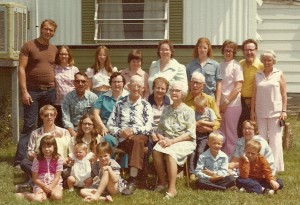 for bringing Great Grandma and Grandpa Knox to Casper for such a lovely visit.
for bringing Great Grandma and Grandpa Knox to Casper for such a lovely visit.
Frank is a very intelligent man, and while his mind may not be quite as sharp as it was in his youth, he still remembers all of us and his little niece, my mother-in-law, Joann Schulenberg. He always calls her on her birthday, and while she won’t have a phone this year, we will make sure that we get them on the phone for that very important call. And perhaps we can surprise him today with a phone call from her, because I think she probably did that too, before Alzheimer’s Disease stole the memory of the date from her. Today is Frank’s 95th birthday. Happy birthday Frank!! Have a great day!! We love you!!
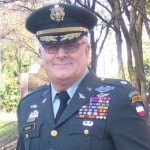 I have been telling you about some of the family connections I have made recently, and how surprised I have been at just who some of these people are. It isn’t always about them being famous, but rather about what amazing things they have done in their lives. So often we don’t hear what our family members have accomplished…mostly because they are too humble to really share all of their accomplishments. Recently, I made a family connection with the Noyes side of my husband, Bob Schulenberg’s family. This would be Bob’s grandmother, Nettie Noyes Knox’s side of the family. The connection was one that in all reality, I stumbled on. I had been searching for information…over a year ago, and I had copied the web addresses of several sites I thought might help, and put them into a Word document. There they sat for far too long. Finally, I found the time to check on one of them, and found the email for Paul Noyes. What an amazing find that was!!
I have been telling you about some of the family connections I have made recently, and how surprised I have been at just who some of these people are. It isn’t always about them being famous, but rather about what amazing things they have done in their lives. So often we don’t hear what our family members have accomplished…mostly because they are too humble to really share all of their accomplishments. Recently, I made a family connection with the Noyes side of my husband, Bob Schulenberg’s family. This would be Bob’s grandmother, Nettie Noyes Knox’s side of the family. The connection was one that in all reality, I stumbled on. I had been searching for information…over a year ago, and I had copied the web addresses of several sites I thought might help, and put them into a Word document. There they sat for far too long. Finally, I found the time to check on one of them, and found the email for Paul Noyes. What an amazing find that was!!
Paul has blessed me with information that I hadn’t found, and I sent him some pictures I had of Noyes family members, to add to his tree. Then he sent back more information on one of the pictures I sent him. He had no idea where that would lead…but I knew, because I had been thinking about a story about him and his family since I received his first response to my email. I love making these new connections, but some of them turn into a great cousinship and friendship too, and those are the most special ones, for sure. I had sent a picture of Eugene Noyes Jr in uniform…but Paul knew from looking at the uniform, that the uniform was from World War II. He knew this because of the 15th Army Air Forces shoulder patch on the uniform. I suppose I might have caught that too, since I had seen my dad’s 8th Army Air Forces shoulder patch, but it was simply something I didn’t notice at all.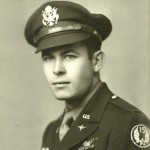
In my defense, I am not a retired after 22 years veteran…and Paul is. Well, that got my curiosity going again. I asked Paul to tell me about his service time. True to the form I have seen with most military men and women…a humble breed…Paul told me a little bit about what he did. He spent most of his 22 year Army career was as an Army aviator. He started out as an Airborne Ranger, then served in Vietnam in Special Forces, where he was wounded. While recovering from the wounds, he was selected for flight school and served in Army Aviation special ops. I did a little research on what Special Operations does exactly, and this is the summary I came up with, “Conduct global special operations missions ranging from precision application of firepower to infiltration, aviation foreign internal defense, exfiltration, resupply and refueling of SOF operational elements.” If you’re like me, that doesn’t clarify much. Upon further research, I found that much of what Special Operations did in Vietnam was to train groups of the Vietnamese Army so they can train the remaining army members. Of course, I am probably generalizing Special Operations to a large degree, and I will have to ask Paul to tell me more about it as soon as I have a chance.
After he was wounded, Paul’s entire career changed when he was selected to become an Army Aviator. Having worked with a pilot for over 18 years now, I have had the opportunity to fly…and I use the term loosely…a small 4 seater plane. Basically what I really did was steer it, and I didn’t do that so well, because it kept climbing, and had to be brought back to level. It was an opportunity given to me with no preparation, and I really enjoyed it. I think to a degree, that is what happened with Paul too. After being wounded, he was given an opportunity to switch gears and do something he never expected to do, and he excelled at it. That is an  awesome career change, and one I look forward to hearing more about.
awesome career change, and one I look forward to hearing more about.
Of course, in a 22 year career, Paul was also building a family. He was married to his lovely wife, Elizabeth, who is an author, and after collaborating with 11 other authors on a book called “A Dozen Apologies”, she released her first book this past August, called “Imperfect Wings”. I look forward to reading both. Paul and Elizabeth have two children, daughter Shari and husband Jimmy Nardello, and their children Cameryn and Reid; and son Chris who is married to Dr Christina Noyes, and they have a son named Owen. I am really looking forward to getting to know these wonderful, new to me cousins as time goes on.

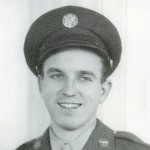 In the height of World War II, on January 14, 1943, President Franklin D Roosevelt made history when he became the first president to travel by airplane on official business. The trip was not without danger. The German U-boats were wreaking havoc on Allied war ships in the Atlantic, and it was decided that a face to face conference was needed to discuss strategy. The man President Roosevelt was going to see, was my fifteenth cousin once removed, Winston Spencer-Churchill. No American President had flown on official business before, but with security in the Atlantic uncertain, Roosevelt’s advisors reluctantly agreed that he should fly. I’m sure his frail health at 60 years of age played a part in their decision too. The secret trip began on January 11, and the plane had to make several stops along the way. They took off from Florida with a first stop in the Caribbean to refuel and allow the president to rest. They then took off and headed south along the South American coast to Brazil, then across the Atlantic to Gambia, finally reaching Casablanca on this day, January 14, 1943.
In the height of World War II, on January 14, 1943, President Franklin D Roosevelt made history when he became the first president to travel by airplane on official business. The trip was not without danger. The German U-boats were wreaking havoc on Allied war ships in the Atlantic, and it was decided that a face to face conference was needed to discuss strategy. The man President Roosevelt was going to see, was my fifteenth cousin once removed, Winston Spencer-Churchill. No American President had flown on official business before, but with security in the Atlantic uncertain, Roosevelt’s advisors reluctantly agreed that he should fly. I’m sure his frail health at 60 years of age played a part in their decision too. The secret trip began on January 11, and the plane had to make several stops along the way. They took off from Florida with a first stop in the Caribbean to refuel and allow the president to rest. They then took off and headed south along the South American coast to Brazil, then across the Atlantic to Gambia, finally reaching Casablanca on this day, January 14, 1943.
It seems strange to us now that they would take such a roundabout route, but things were different then. The Boeing 314 Flying Boat that had been dubbed the Dixie Clipper was a big heavy plane. It had a flight range of 3,500 miles, and the direct route would have been about 4326 miles, making at lease one stop necessary. Since the Secret Service considered air travel for a president as risky anyway, I’m sure they wanted to take a 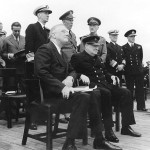 route that would keep them as far away from any fighting as they could. Also, the final leg of the trip required that the group transfer to an Army transport plane. The C-54 was required to fly at 15,000 feet to cross the Atlas Mountains…an altitude that seems insignificant today, but must have been quite high then. The Secret Service personnel and FDR’s advisors were worried about the oxygen levels affecting the president, and in the end, he did have to go on oxygen for a time during that part of the flight.
route that would keep them as far away from any fighting as they could. Also, the final leg of the trip required that the group transfer to an Army transport plane. The C-54 was required to fly at 15,000 feet to cross the Atlas Mountains…an altitude that seems insignificant today, but must have been quite high then. The Secret Service personnel and FDR’s advisors were worried about the oxygen levels affecting the president, and in the end, he did have to go on oxygen for a time during that part of the flight.
The flight was mastered successfully, and the two men were safely tucked into the Anfa Hotel where Roosevelt and Churchill were both in suites that were close together, making it the perfect place for the conference to take place…after the rooms were cleared of listening devises that had been planted by unknown persons, that is. The advisors and chiefs of staff did most of the hard work of the negotiations, but the presence of Roosevelt and Churchill kept them on task and working toward an agreement. The conference was very important to both sides, as the British were being hit very hard, and Roosevelt needed to keep the American troops advancing and winning their battles, so he could demonstrate to the American people that the tide of this war was turning. People get weary of war quite quickly, and in order to keep their support, victory in battle is key.
The Casablanca Conference was looked at by some as a victory for the British negotiators, because Churchill’s strategy prevailed, but they had missed the fact that the Americans also gained British commitments to long-term goals that went beyond the immediate objectives in the Mediterranean. The Americans agreed to attack Sicily after the victory in North Africa and the British agreed to allow a massive buildup of Allied Forces in  Britain, which would allow for an invasion of France with a target date of May 1, 1944. The invasion actually took place on June 6, 1944, and would become a day we all know as D-Day, when the troops stormed the beaches of Normandy…and that is where my dad came in. Since he was one of the Allied Forces that was stationed in England, his B-17G Bomber was one of those that provided cover for that invasion. It seems quite strange to me that a conference that took place over a year before, and 2 months prior to my dad’s enlistment, would ultimately place him in a position to fight in one of the most well known battles of World War II.
Britain, which would allow for an invasion of France with a target date of May 1, 1944. The invasion actually took place on June 6, 1944, and would become a day we all know as D-Day, when the troops stormed the beaches of Normandy…and that is where my dad came in. Since he was one of the Allied Forces that was stationed in England, his B-17G Bomber was one of those that provided cover for that invasion. It seems quite strange to me that a conference that took place over a year before, and 2 months prior to my dad’s enlistment, would ultimately place him in a position to fight in one of the most well known battles of World War II.
 I was looking at some of my uncle, Bill Spencer’s family history information yesterday, and I came across a comment he made about some of the pictures. It was about the National Youth Administration that was transferred to the War Manpower Commission in 1941. When he mentioned that it was about educating the nation’s youth, I immediately got on the defensive, because I thought that it almost sounded like the Nazis pulling children out of their homes to train them the way the government wanted them to be trained. Of course, that couldn’t be further from the truth. In reality, and had I read the rest of Uncle Bill’s comments before I got touchy about it, I would have known that. I think sometimes, we have a preconceived idea about things, and we don’t really understand exactly what is going on before we fly off the handle.
I was looking at some of my uncle, Bill Spencer’s family history information yesterday, and I came across a comment he made about some of the pictures. It was about the National Youth Administration that was transferred to the War Manpower Commission in 1941. When he mentioned that it was about educating the nation’s youth, I immediately got on the defensive, because I thought that it almost sounded like the Nazis pulling children out of their homes to train them the way the government wanted them to be trained. Of course, that couldn’t be further from the truth. In reality, and had I read the rest of Uncle Bill’s comments before I got touchy about it, I would have known that. I think sometimes, we have a preconceived idea about things, and we don’t really understand exactly what is going on before we fly off the handle.
The education effort that my uncle was talking about was set up by the National Youth Administration through the War Manpower Commission, and had to do with the upcoming and inevitable entrance of the United States into World War II. The skills that were going to be needed to build the equipment needed for our troops to fight in the war were very different from the skills the nation’s youth had at that time, because many of them were farmers. The nation was going to need welders, machinists, and sheet metal workers desperately. The training program was designed to provide training for youth 16 to 25 years of age. The plan was that the ones who were not drafted could help with the war effort at home.
It was this program that trained my dad, Uncle Bill, Aunt Laura, and Aunt Ruth to weld, and gave them jobs in the shipyards in several different capacities, mostly as Rosie the Riveters. Of course, while Uncle Bill did a similar job to the ones done by his sisters, I don’t think he would take too kindly to the name Rosie the Riveter. Nevertheless, it was on May 1, 1942 that Uncle Bill began his training, and shortly there after, he talked my dad into doing the training too. Uncle Bill had hoped that welding would keep them both on the home front, but when that was not to be, they both went to sign up. Dad was accepted, but Uncle Bill was not, because of flat feet and a hernia. Still, the welding skill was not something that would ever be a waste where my dad was concerned, because he worked as a welder for most of his life after the war was over.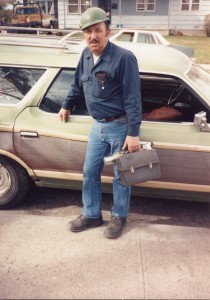
The National Youth Administration officially operated from June 26, 1935 to 1939, and was designed to provide training and help find jobs for people during the Great Depression. It was part of The New Deal programs set up by President Franklin D Roosevelt during his first term in office. I don’t often agree with government run programs, I suppose this one had it’s place. Many of the people who benefitted from the chance to train themselves for a new skill were farmers who didn’t have many other skills, and it was the training my dad received there that supported our family for his entire working life. The National Youth Administration was officially transferred to the War Manpower Commission in 1942, and officially folded in 1943. It was most likely due to lack of funding to continue the program, but I suppose it served a greater purpose during the war years, and now was no longer necessary.

 When I talked to my dad about his time at Great Ashfield in Suffolk, England, we talked about, among other things, the sign at the town entrance that still stands today, after all these years since the end of World War II. The picture of the B-17G Bomber flying low over the town is not something that would necessarily be well received these days, when people are so quick to complain about the planes when they live near an airport. I understand why people would not like planes flying low on takeoffs and landings these days, but the planes that fly over my house really don’t bother me at all. Nevertheless, my dad assured me that the people of Great Ashfield felt anything but irritation at the low flying planes that graced their skies during World War II.
When I talked to my dad about his time at Great Ashfield in Suffolk, England, we talked about, among other things, the sign at the town entrance that still stands today, after all these years since the end of World War II. The picture of the B-17G Bomber flying low over the town is not something that would necessarily be well received these days, when people are so quick to complain about the planes when they live near an airport. I understand why people would not like planes flying low on takeoffs and landings these days, but the planes that fly over my house really don’t bother me at all. Nevertheless, my dad assured me that the people of Great Ashfield felt anything but irritation at the low flying planes that graced their skies during World War II.
England was among the nations who had taken some serious hits by the Nazi war machine in the early days of World War II, prior to the entrance of the United States into the war. In fact, it was on this day, December 29, 1940 that London took a massive hit during a German raid. The German planes had been targeting London since August of 1940 as payback for the British attacks on Berlin. In September the Germans dropped 337 tons of bombs on docks, tenements, and the streets in one of London’s poorest districts. Then came December 29, 1940. The attack on that day produced widespread destruction of not just civilians, but also many of London’s cultural relics. The bombing was relentless and as a result, 15,000 separate fires were started. Historic buildings were severely damaged or destroyed. Among them, the Guildhall, which was an administrative center of the city 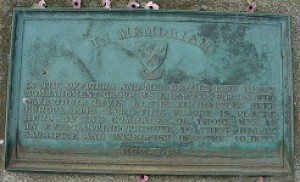 that dated back to 1673, but contained a 15th century vault. Eight Christopher Wren churches were also damaged or destroyed. St Paul’s Cathedral caught fire, but was saved by the firefighters who risked their own lives to save it. Westminster Abbey, Buckingham Palace and the Chamber of the House of Commons were also hit, but the damage to these was less severe. These attacks, that went on from September of 1940 through May of 1940, were known as the London Blitz, and they killed thousands of civilians.
that dated back to 1673, but contained a 15th century vault. Eight Christopher Wren churches were also damaged or destroyed. St Paul’s Cathedral caught fire, but was saved by the firefighters who risked their own lives to save it. Westminster Abbey, Buckingham Palace and the Chamber of the House of Commons were also hit, but the damage to these was less severe. These attacks, that went on from September of 1940 through May of 1940, were known as the London Blitz, and they killed thousands of civilians.
It wasn’t until Pearl Harbor was attacked on December 7, 1941, that the United States entered World War II, and soon after came the time that my dad spent at Great Ashfield beginning in early April of 1944 until he went home in October of 1945. While it may have seemed to many that we were somewhat late coming to the party, the war torn nations around the world were happy to see us arrive. It wasn’t that we were going to be the heroes riding in on the white horses, but we meant instant reinforcements to nations that needed assistance badly. The airmen were well received in the towns surrounding Great Ashfield, and the other air bases in England, but it was Great Ashfield that felt such gratitude that they went to the length of making and leaving to this day, the sign showing the B-17G Bomber flying low over the local church. There is also another memorial honoring the men of the 8th Air Force and the 385th Heavy Bombardment Group.
The reasons for the warm feelings toward the 8th Air Force and the 385th Heavy Bombardment Group are obvious. It was so much more than just the reinforcements the United States provided. While talking to my 
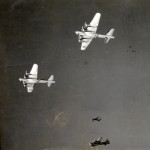 dad about this, he revealed that the main reason that they were so grateful is that the safest times for the area were when the B-17G Bombers were flying overhead. The German aircraft would become really scarce when the Bombers were around, because they didn’t want to be shot down either. The constant activity surrounding the air field made it almost impossible for the Germans to attack the area. Bombings are horrible, and take a huge toll on the civilians, as well as buildings. I suppose I would be eternally grateful for those planes, those men, and the United States 8th Air Force too. It gave peace of mind.
dad about this, he revealed that the main reason that they were so grateful is that the safest times for the area were when the B-17G Bombers were flying overhead. The German aircraft would become really scarce when the Bombers were around, because they didn’t want to be shot down either. The constant activity surrounding the air field made it almost impossible for the Germans to attack the area. Bombings are horrible, and take a huge toll on the civilians, as well as buildings. I suppose I would be eternally grateful for those planes, those men, and the United States 8th Air Force too. It gave peace of mind.
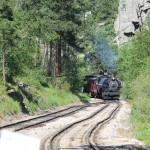 I read an article in the Casper Star Tribune yesterday that made me think about the many changes in the railroad over the years. When my grandfather, Allen Luther Spencer was working on the railroad as a carpenter during World War II, and for years before that, it took a number of people to run a train. The freight trains during World War II typically had seven people aboard…an engineer, conductor, up to four brakemen and a fireman. With all the trains that were running…not nearly as many as we have today…the railroad supplied a lot of jobs. This was just to run the actual train. The maintenance personnel, the station managers, and others who were required to keep the trains running smoothly, added to the number of people it took to ultimately move the trains along the tracks at any given moment. The trains of that era weren’t anywhere near as long as they are these days either.
I read an article in the Casper Star Tribune yesterday that made me think about the many changes in the railroad over the years. When my grandfather, Allen Luther Spencer was working on the railroad as a carpenter during World War II, and for years before that, it took a number of people to run a train. The freight trains during World War II typically had seven people aboard…an engineer, conductor, up to four brakemen and a fireman. With all the trains that were running…not nearly as many as we have today…the railroad supplied a lot of jobs. This was just to run the actual train. The maintenance personnel, the station managers, and others who were required to keep the trains running smoothly, added to the number of people it took to ultimately move the trains along the tracks at any given moment. The trains of that era weren’t anywhere near as long as they are these days either.
As technology became more sophisticated, fewer people were needed to run a train, and by the 1970s, the number of people on a freight train had dropped to five people, and by 1991, only the engineer and the 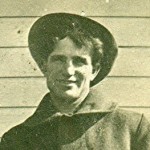 conductor were needed to run the train. When you consider that the trains have become so long that it can take twenty minutes to get the whole train through a crossing, that seems amazing to me. I guess it is amazing to a lot of other people too, because as the railroads are trying to eliminate one of those positions as well, a lot of people are quite worried about the safety of the trains. What strikes me as funny, however, is that the concern is that if they need to disconnect a car so emergency vehicles can get through, the engineer can’t leave his post to do so. I’m sure that in the future that part will be handled too, because technology is getting to the point whereby the train really could be run without a driver, just like the model trains are.
conductor were needed to run the train. When you consider that the trains have become so long that it can take twenty minutes to get the whole train through a crossing, that seems amazing to me. I guess it is amazing to a lot of other people too, because as the railroads are trying to eliminate one of those positions as well, a lot of people are quite worried about the safety of the trains. What strikes me as funny, however, is that the concern is that if they need to disconnect a car so emergency vehicles can get through, the engineer can’t leave his post to do so. I’m sure that in the future that part will be handled too, because technology is getting to the point whereby the train really could be run without a driver, just like the model trains are.
Much like the model trains, there is a controller at a central location who can see all the trains for his area. In reality, they probably could control the train with no one on it, but how strange that would be…especially when talking about passenger trains. But then, with subways, and airport trains, we often get on the train, and never see if anyone is running it. In airports, the voice telling you of your arrival is even 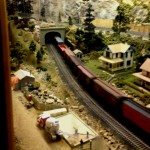 mechanical. I have to wonder if anyone is running those, and maybe someone out there will clarify that one for me. Someday, or even already, we will probably ride trains and never give a second thought to the fact that there is no engineer. Everything has become so technical, and we have reached a point of being so used to robotics, that we don’t even give a second thought to the aspect of someone being in control of this massive train we have just boarded…and people have said that flying is like being in a cattle truck. Turning control of our lives to someone we don’t know, or even to a robot, seems very strange, even today, but what would the people of my grandfather’s era have thought about having no one to run the train. I’m quite sure they would never have boarded at all.
mechanical. I have to wonder if anyone is running those, and maybe someone out there will clarify that one for me. Someday, or even already, we will probably ride trains and never give a second thought to the fact that there is no engineer. Everything has become so technical, and we have reached a point of being so used to robotics, that we don’t even give a second thought to the aspect of someone being in control of this massive train we have just boarded…and people have said that flying is like being in a cattle truck. Turning control of our lives to someone we don’t know, or even to a robot, seems very strange, even today, but what would the people of my grandfather’s era have thought about having no one to run the train. I’m quite sure they would never have boarded at all.

